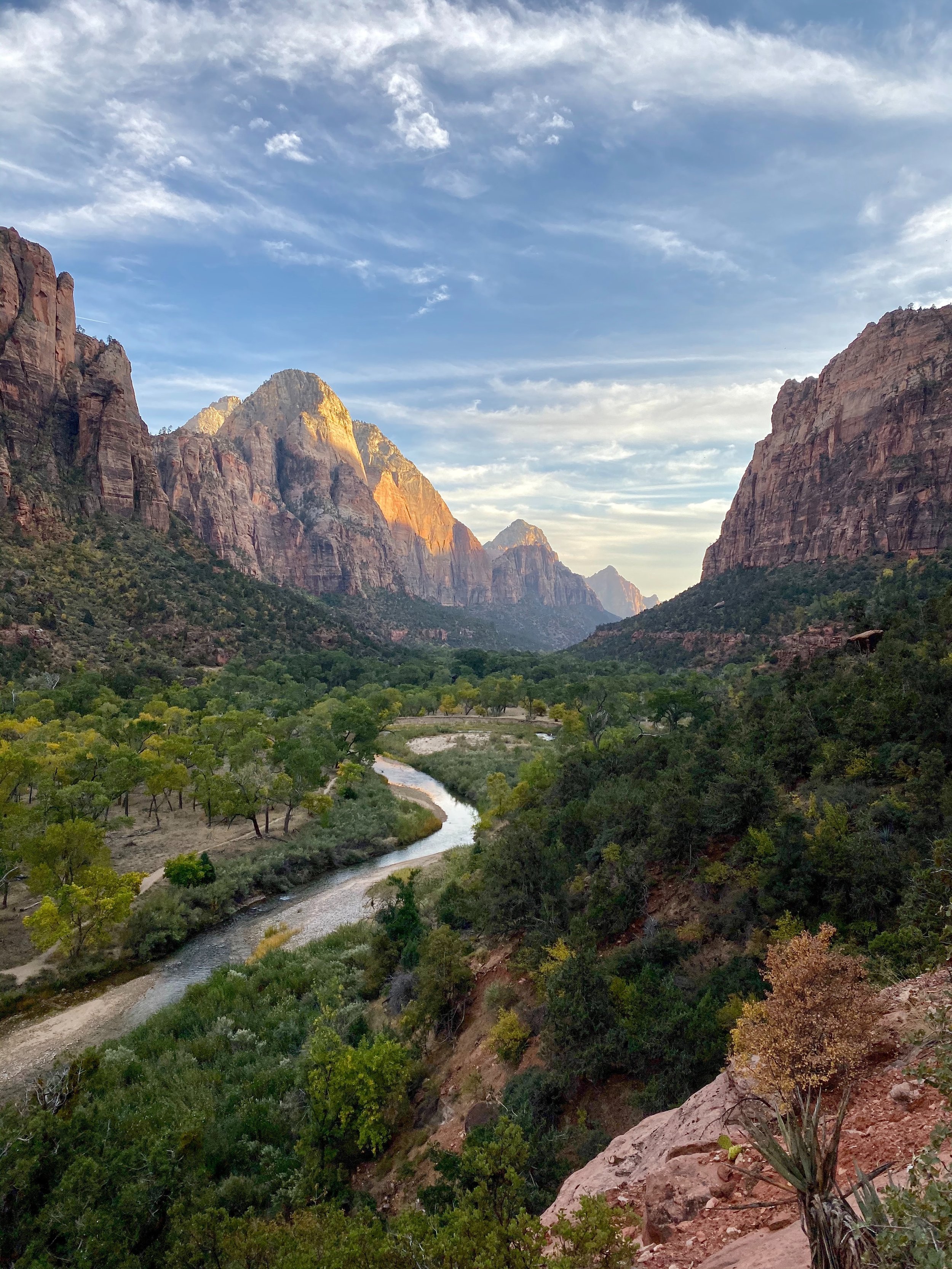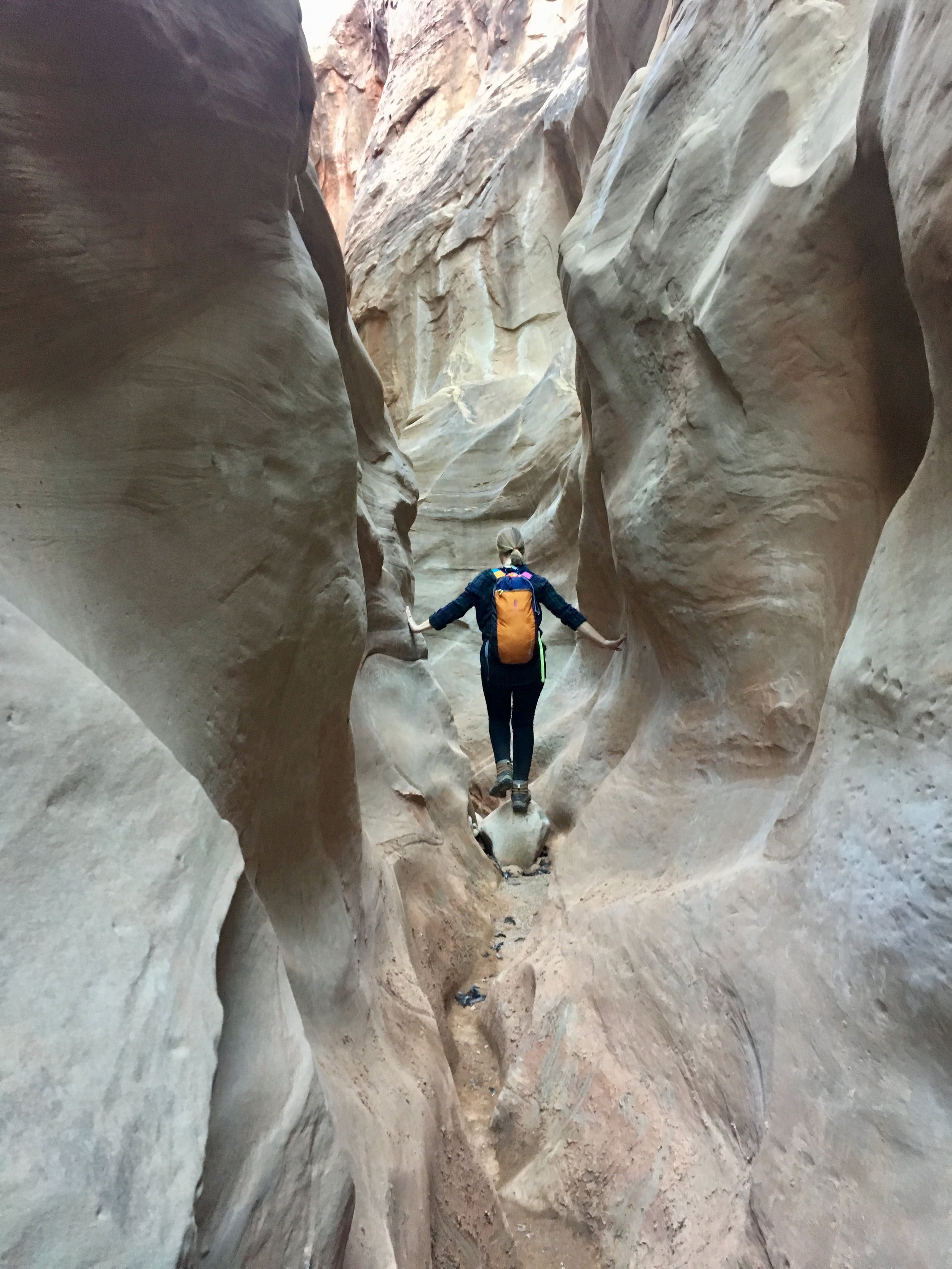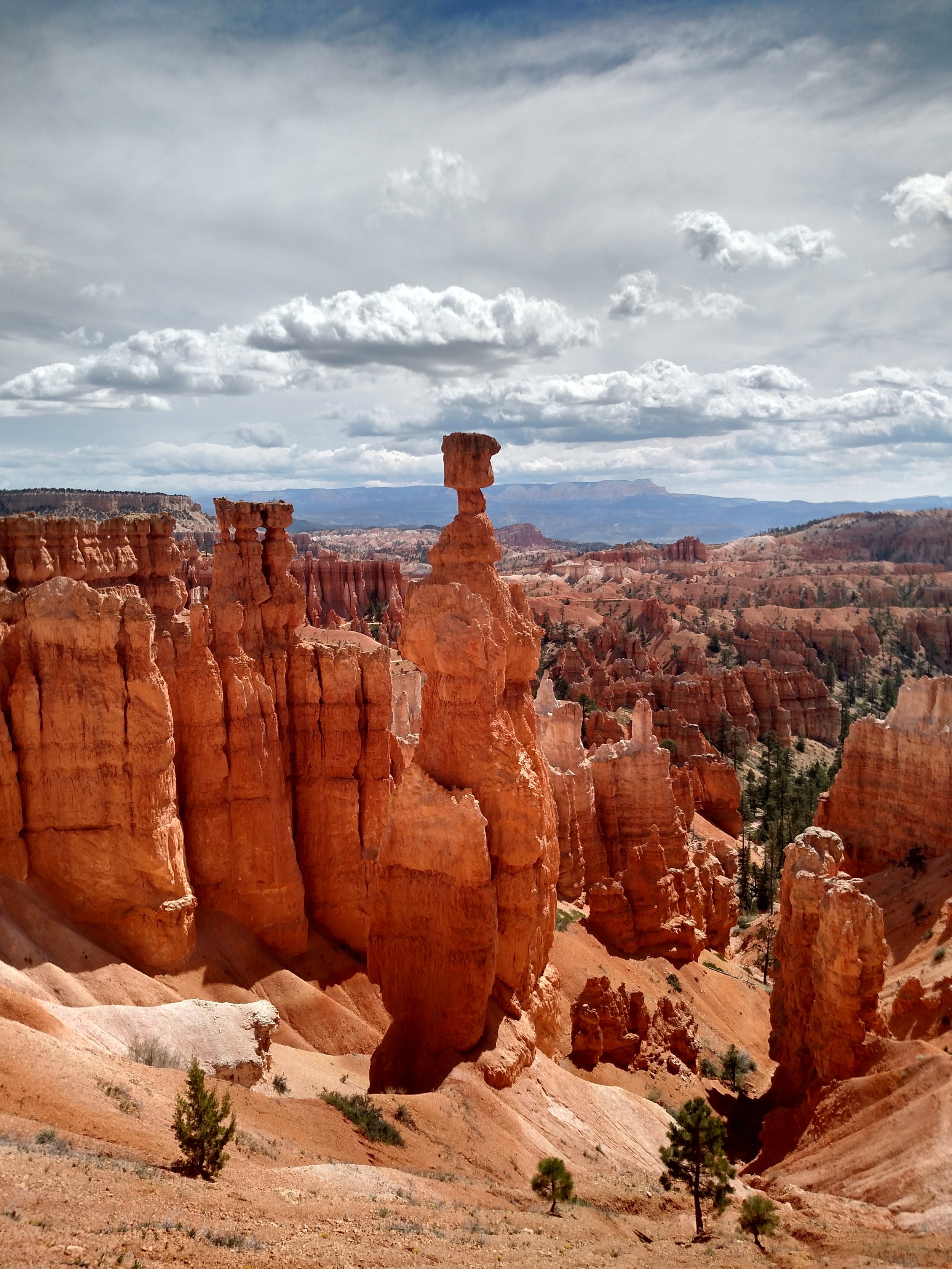Roam Guide / SW Utah
While each of our guides aims to offer simple advice in a format that's easy to navigate and share, we recognize that not all travel enthusiasts can translate that information into an actionable plan. We also understand that not everyone has the bandwidth to take on the details of planning a trip. If you’d like us to outline a custom itinerary on your behalf, just let us know.
Kelly Moorman is an adventurer, content creator, and lover of the outdoors. A storyteller at heart, she enjoys sharing her experiences through the written word. Though not a Montana native, she has proudly called the area home for nearly a decade. She can most often be found wandering through forests, summiting mountains, and communing with nature with her husband Lawson and dog Abel.
Where are we talking about?
Southwestern Utah- Zion National Park, Bryce Canyon National Park, and Grand Staircase-Escalante National MonumentI have a confession to make. I’m totally obsessed with the desert, in a “I like you as more than a friend” kind of way. There are so many different types of beauty in our world. For me, the mountains, which I call home, are an undeniable, in-your-face, almost intimidating type of beauty. The desert, on the other hand, is a grittier, more exotic beauty that not everyone “gets.” Hence the reason why when I told my friends and family we were headed to Utah, they responded with “Why?” Places like the mountains need no explanation. Apparently, the desert does. So, allow me to explain exactly why the desert deserves more praise than it gets.
“All fall, I counted down the days until my trip to Southwestern Utah like a five-year-old excitedly counts down the days to Christmas. A paper countdown chain may or may not have been involved.”
When to go?
May- November Really it’s a matter of personal preference but we went in early November and couldn’t be happier with our decision. The thing about the desert is that it’s hot. Shocking, I know. It’s also startlingly sunny. I had actually forgotten that cloud cover was a thing until we returned home. The temperatures are much cooler during the fall than during the blistering hot summer but are still warm enough to be comfortable in a tank top or t-shirt during the day. There’s one other reason why late fall is the perfect time for a trip to the desert, and for me, it’s a pretty major one: fewer crowds. Zion National Park ranks as the third busiest national park in the U.S. and had a record 4.5 million visitors in 2017; Bryce Canyon National Park recorded 2.6 million visitors in 2017. That’s a lot of people. I’m an introverted person with an adventurous spirit, and as a result, I prefer to enjoy the beauty of the natural world in relative solitude. Of course, there were still plenty of people in both Zion and Bryce Canyon in early November.
“But the most crowded I ever felt was when a posse of intrepid chipmunks decided they wanted what was left of my lunch.”
How to get there?
Zion National Park, Bryce Canyon National Park, and Grand Staircase-Escalante National Monument (specifically the “Canyons of the Escalante” section), are all located within roughly two and a half hours of one another, and the drive between the three is an easy one.
If you have the option, I recommend road tripping it. And I’m not just saying that because I have an irrational fear of flying. My husband and I essentially lived out of our 2002 Subaru Forester for eight days, which kept this adventure on the more affordable end of the scale. There are also some pretty rough dirt roads throughout Grand Staircase-Escalante (more on that later), and the thought alone of taking a rental down them stresses me greatly. I don’t really care to find out if the “You break it, you buy it” mantra holds true with rental vehicles.
Zion National Park is located in Springdale, Utah, which is in the southwest corner of the state. It’s just 2.5 hours from Las Vegas, 4 hours from Salt Lake City, and approximately 7 hours from Los Angeles. The McCarran International Airport in Las Vegas and the Salt Lake City International Airport are the two best options for air travel for those of you brave enough to leave your fate up to two people you’ve never met. Las Vegas is typically cheaper and is a bit closer to Zion, if you choose this route you could also end your trip at the Grand Canyon.
From Zion, we headed to Bryce Canyon National Park, which is located near the city of Bryce and is about 90 miles—2 hours—northeast of Springdale. It’s an easy drive on US-89.
From Bryce Canyon, we headed 50 miles—an hour—northeast to Escalante, Utah, where we stayed for our Grand Staircase-Escalante leg of the trip. A picturesque drive on Utah’s Scenic Byway 12 will leave you wishing the hour drive was even longer.
Where should we stay?
Lodging is also more affordable during the “off” season. Rates near Zion, Bryce Canyon, and Grand Staircase-Escalante are always higher—in some cases considerably so—during the summer. As is always the case with any place that attracts a lot of people, there are plenty of VRBO options as well. These book quickly though, so if you’re hoping to go this direction, I wouldn’t leave it up to chance.
If you’re the camping type - there are three designated campgrounds, Lava Point, Watchman, and South Campgrounds in Zion National Park and two, Sunset and North Campgrounds in Bryce Canyon National Park. There are also a variety of designated campgrounds throughout Grand Staircase-Escalante. Tent camping typically costs $20/night, and camping with electric hook-ups costs $30/night. Camping in this area is very popular, and campgrounds are often full by mid-morning from mid-March through late November. You’ll want to find your campsite as early as possible—like start looking when the sun comes up early—to ensure you get a spot.
For those of you who prefer a more traditional roof over your head, there are a myriad of hotels and motels near all the parks. Like campsites and rental property, rooms book quickly.
Zion National Park - There are plenty of options in Springdale but you’ll pay a higher price for proximity to the Park. If that’s really important to you then check out Zion Canyon BnB. Another contributor favorite in the area is The Cliffrose Lodge and Gardens right by the park entrance, which includes a fabulous breakfast and is within walking distance to the park entrance and shuttle. Other garden variety hotels in close proximity and with good reviews are Best Western Plus Zion Canyon, La Quinta Inn & Suites, and Majestic View Lodge. If you don’t mind the drive, there are also lodging options in neighboring towns, such as Hurricane, which is about 30 minutes outside of the Park. The Wingate by Wyndham is one of the best reviewed and highest rated in terms of value.
Bryce Canyon National Park - options are much the same, with our contributor favorite being The Lodge at Bryce Canyon, a historic hotel with good food and easy access to attractions.
Grand Staircase-Escalante National Monument - we were pleasantly surprised by the number of lodging choices given the small size of Escalante —we’re talking less than 1,000 people small. There are a handful of charming options including, The Canyon Country Lodge which sits perched atop a hill and looks quite impressive from the road, especially in such a tiny town full of equally tiny buildings. Escalante Yurts is another great option, especially if you’re looking for something a little out of the ordinary. Complete with continental breakfast (served in your room!), Wi-Fi, on-suite bathrooms, and outdoor decks, the owners of Escalante Yurts take “glamping” to a whole new level. Lastly, Escalante Outfitters offers perhaps the most rustic experience outside of camping. These seriously charming log cabins will transport you back to simpler times (but simpler times with running water). If you don’t mind a shared bathhouse, this is a great option.
What should we do?
Start exploring immediately. There is so much to see in Zion, Bryce Canyon, and Grand Staircase-Escalante, from slot canyons to waterfalls to hoodoos. Not sure what a “hoodoo” is? Read on.
*In 2021 certain parts of Zion will require reservations. The specifics of which, are nicely outlined in this article and can get quite complicated.
Zion National Park - boasts not only breathtaking hiking, but some of the most unique I’ve ever experienced. The majority of the hikes are located along the Zion Canyon Scenic Drive, past Canyon Junction and accessible only by shuttle in spring through fall. The shuttles are free of charge and run frequently—we never waited more than a few minutes.
Lower Emerald Pool trail is one of the most popular hikes in the Park, likely because it’s incredibly rewarding, especially considering its short length. I found this hike to be one of the most serene in the Park. The hike to Lower Emerald is just over a mile roundtrip and can be enjoyed by park visitors of all ages and hiking abilities. The trail leads to a waterfall that delicately spills over an alcove into a clear pool below. From the sound of the water collecting in the pool to the light drops of water that collect on your skin, this trail offers a lovely, reflective experience that can easily make you forget you’re in the company of others. You can extend the hike—and increase the intensity—by continuing past the lower section to Middle and Upper Emerald Pools.
While Angel’s Landing is Zion National Park’s most popular trail, I would argue that Observation Point is better. You actually look down on Angel’s Landing from Observation Point—which is 730 feet higher—so you get that whole “two-birds-one-stone” kind of thing. Observation Point sits at the very top of the canyon, offering some of the most extraordinary views of Zion National Park. That is, if you’re willing to climb the 2,200 feet of elevation to get to the top.
The Narrows of Zion are somewhat legendary, and rightly so as this trail is absolutely magical. The 9.4-mile Narrows hike involves trekking through the Virgin River as it flows through the 1,000-foot tall canyon walls. It also involves constantly craning your neck as you take in the exquisite 360-degree views. If not obvious by my previous “trekking through the Virgin River” statement, you will get wet on this hike. Water levels fluctuate from day to day and can range from ankle-deep to waist-deep. If you’re worried about getting wet (and cold!), you can rent equipment in the form of water booties, a drysuit, and a really cool walking stick from Zion Adventure Company.
“Zion felt kind of like the desert version of Glacier. Bryce Canyon, however, was something else entirely.”
Bryce Canyon National Park - was a bit of a shock for us. I had heard plenty about Zion before our trip, but never had I heard much about Bryce Canyon. Its landscape is incredibly unique—and incredibly orange. There’s something otherworldly about this Park, likely an effect of the “Hoodoos,” the tall, thin spires of rock that make Bryce Canyon so distinct.
Grand Staircase-Escalante National Monument - is absolutely massive to explore and this land is among some of the most remote in the country. For this reason, I had a very difficult time choosing which hikes we would accomplish in our few days.
Lower Creek Falls begins as a true desert hike—exposed, hot, and covered in cacti—and ends in a towering waterfall so magnificent you may question whether or not it’s a mirage. The waterfall itself is a sight to behold, but just like a late-night infomercial, there’s more! As you walk between mineral-streaked cliffs composed of Navajo sandstone, be sure to keep an eye out for pre-historic pictographs that adorn the cliff walls.
Next up are Peek-a-boo and Spooky Slot Canyons. Remember my earlier mention of dirt roads of questionable condition? You’ll take one of those to get to this hike. Peek-a-Boo and Spooky Slot Canyons share a trailhead located 26 miles down Hole-in-the-Rock Road. Saddle up, because it’s going to be a bumpy ride. While the drive may feel like an adventure all its own, the real fun starts when you set foot on the trail.
Peak-a-Boo Gulch is a short but marvelous hike and is a good way to dip your toe into the enchanting world of slot canyons. It’s neither very long nor physically demanding, though you may need some rock-scrambling skills to navigate its twists and turn. Upon exiting Peek-a-Boo Gulch, you can hike roughly half a mile east until you reach the stream bed above Spooky Gulch, named so because this slot canyon is, well, spooky. It’s one of the narrowest slot canyons in the area, only 10 inches wide in some spots. Needless to say, this slot canyon isn’t for the claustrophobic.
We ended our trip with a hike through Willis Creek Narrows, which I would have happily called home for the rest of my days. This trail is actually located back towards Bryce Canyon National Park outside of a town called Cannonville and involves another one of those epic dirt road excursions. Even if you never set foot outside of your car, the amazing scenery along Cottonwood Canyon Road is worth it. At the start of this hike, the canyon walls are relatively short and the canyon itself is relatively wide. This quickly changes as the walls ascend higher and higher from the creek bed and the canyon begins to seemingly close in on itself. The curvaceous rock walls have been intricately carved by thousands of years of running water and serve as a beautiful reminder that Mother Nature is the world’s greatest artist. You hike in the creek bed for most of this hike, so you will want to wear waterproof boots.
What is the one can't miss item on your itinerary?
I would absolutely recommend the Queen’s Garden/Navajo Loop trail in Bryce Canyon Although it faces some stiff competition, it’s arguably the most awe-inspiring hike in the Park, meandering through the most spectacular landscape. Every turn offers a perspective as unbelievable and majestic as the one before. Hoodoos of varying shades of orange and red, from the color of a sunset to the color of fired brick, rise up spectacularly from the floor and walls of the canyon and take on a life of their own.
What would you do differently next time?
I’d look at adding in the spectacular Capitol Reef area which has bison trails, petroglyphs, and more great hiking.
What should we take with us?
If you’re an avid frequenter of National Parks, I highly recommend purchasing an America the Beautiful- The National Parks and Federal Recreational Lands Pass for $80, which covers entrance fees to every National Park and Federal Lands Recreation Area across the U.S. for 12 months from the month of purchase. By comparison, Zion and Bryce Canyon National Parks each charge $35 for vehicle entrance for a seven-day pass.
As far as clothing goes, I highly recommend packing layers. A flannel is a great option for hiking around the canyons, which shield you from the heat of the sun. I used to splurge on flannels, but if you check seasonally you can find a more affordable option from retailers like Old Navy. A vest is also a great option as it’s often not cold enough to warrant a jacket, but also not warm enough for just a shirt. I even slept in mine a few times on our trip. You’ll also want to bring a pair of waterproof hiking boots. I’ve gotten many years of use out of the Montara boot from Ahnu. This lightweight, waterproof boot offers a little more flexibility than a super stiff boot, making it extremely comfortable. Speaking of waterproof, gaiters are also a good idea, not to mention a must-have for any adventurer. Wherever I go, my gaiters go too. I’ve said this before and I’ll say it a hundred times more, wear sunscreen! I’m all for aging, but I’m not exactly jonesing to speed the process up. This “Unseen” facial sunscreen from Supergoop is the bomb. Lastly, you absolutely need a daypack for all your adventuring. I am a huge fan of Cotopaxi, whose tagline is “Gear for Good.” This Certified B-Corp dedicates 2% of their revenue to alleviating poverty. They also take a stand against the wastefulness of consumerism by making their gear out of scraps of leftover fabric, which is pretty bada$$. My husband and I each have a Luzon 18L Daypack, which is the perfect size for day hikes. This simple pack doesn’t have a ton of bells and whistles, but it more than gets the job done, is of sturdy construction, and is at a great price point.
What’s your best piece of advice for this type of trip?
Be flexible. My husband and I have been fortunate enough to go on some truly incredible trips during our six years together, from a month-long backpacking trip across Nicaragua to a two-week honeymoon in Kauai complete with a five-day Na Pali Coast outing. I can say with certainty that none of our trips would have been as enjoyable without a little flexibility. And that’s coming from a control freak. Sure, there’s something to be said for having a plan. But there’s an incredible amount of value in having the willingness to adjust when things don’t go according to that plan—which, in my experience, happens a lot. Our flexibility has allowed us to live our lives to the fullest and make the most of every trip. It has allowed us more time in places we unexpectedly fell in love with. And it has allowed us to travel trails that would have otherwise gone untraveled, to discover wonders that would have otherwise gone undiscovered, and to know adventures that would have otherwise gone unknown.










